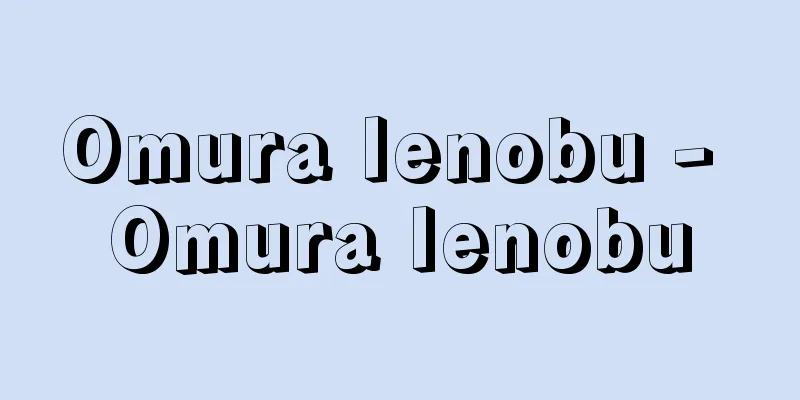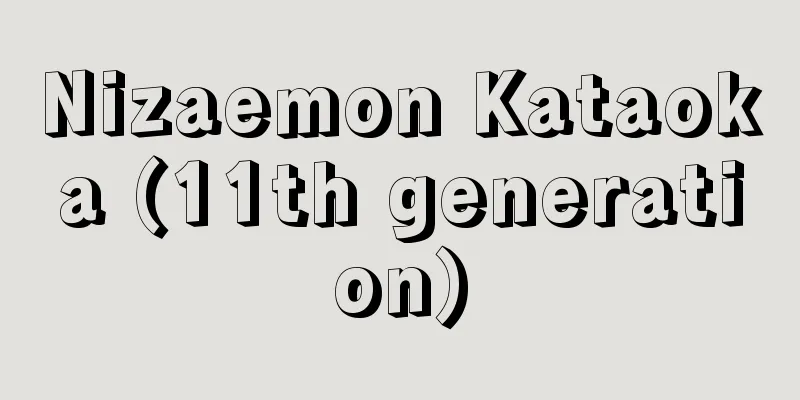Kukai

|
A monk in the early Heian period. The founder of Shingon Buddhism. Known by the posthumous name Kobo Daishi. [Yukatsu Miyasaka, June 20, 2017] LifeHe was born in the 5th year of the Houki era in Byobugaura, Tado County, Sanuki Province (Zentsuji, Kagawa Prefecture) as the third son of Saeki no Atatakimi and his mother, who was from the Ato clan (according to legend, Tamayorihime). His childhood name was Mao. He was called Shindo (child prodigy) and Totomono (precious treasure) when he was young. He studied Chinese classics under his maternal uncle Ato no Otari. He went to Kyoto at the age of 15 and entered university at the age of 18, where he studied "Mao Shi" and "Shangshu" under Umasake no Kiyonari and "Shunju Zuo Zhuan" under Okada no Ushikai. One day, he met a monk and was taught the Gumonjiho. He then devoted himself to training, traveling to sacred places such as Mount Otaki in Awa (Tokushima Prefecture), Cape Muroto in Tosa (Kochi Prefecture), Mount Ishizuchi in Iyo (Ehime Prefecture), and Mount Kinpu in Yamato (Nara Prefecture). Thus, he made up his mind to become a monk, and at the age of 24, he wrote "Sango Shiiki" (another version or draft version is "Rouko Shiiki" in the possession of Kongobu-ji Temple on Mount Koya; a national treasure). It is a kind of comparative philosophical treatise in the form of a philosophical drama, discussing the superiority or inferiority of Confucianism, Taoism, and Buddhism, and arguing that Mahayana Buddhism is the most superior teaching. His whereabouts for the next seven years or so are completely unknown, but it is believed that he had already studied Esoteric Buddhism in addition to the Nara Rokushu sects.It is also believed that he discovered Mount Koya during his younger years. In 804 (23rd year of the Enryaku era), at the age of 31, he boarded a ship belonging to the Tang ambassador Fujiwara no Kadonomaro (755-818) with Tachibana no Hayanari and others, and narrowly escaped death during a storm on the way, entering Tang China. He entered Chang'an in December of that year. The following year, 805, he studied Sanskrit and Indian studies under Tripitaka Prajna and others at the Lisen-ji Temple in Chang'an, and from June of that year, he received instruction in esoteric Buddhism from Huiguo of the Seiryu-ji Temple for six months, becoming the eighth patriarch of Shingon Esoteric Buddhism. On December 15 of the same year, when Huiguo died at the age of 60, he was chosen from his disciples to write the memorial inscription. During his stay in Chang'an, he interacted not only with Buddhists from the Tang Dynasty, but also with many literati and artists, and absorbed a wide range of culture. He returned to Japan in October 806 (Daido 1), bringing with him a huge number of esoteric Buddhist scriptures, Buddhist statues, law codes, mandalas, and other cultural artifacts, and in December he submitted the "List of Items Brought to Japan" to the Imperial Court. In 809, he entered Takaosan-ji Temple (Jingo-ji Temple) in Kyoto, and the following year, 810, he performed a ritual to pacify the nation. In 812 (Kōnin 3), he administered the Kanjō (a ceremony in which water is poured on the head to enthrone a Buddha) to Saichō of Mount Hiei and his disciples. In June 816, at the age of 43, he petitioned Emperor Saga to open Mount Koya for the nation and as a training ground for ascetics, and received imperial permission on July 8. In May 819, he began construction of the temple. In this way, Mount Koya, along with Mount Hiei of the Tendai sect, became a base for mountain Buddhism in the early Heian period. On the other hand, in September 821, he renovated Manno-no-ike Pond (Manno-cho, Kagawa Prefecture) in Sanuki, Shikoku, and worked hard for the farmers. In January 823, he was entrusted with To-ji Temple (Kyoogokoku-ji Temple) in Kyoto, which he designated as the main training center for Shingon Esoteric Buddhism in Kyoto, and worked to train the next generation. In December 828 (Tencho 5), he opened Shugeishuchi-in, Japan's first school for educating the common people, to the east of To-ji Temple. In January 835 (Jowa 2), he performed the Goshichinichimishuho (Later Seven Days' Ritual) at Shingon-in Temple in the Imperial Court, and passed away at Mount Koya on March 21 of the same year. He was 62 years old. In 921 (Engi 21), Emperor Daigo bestowed the posthumous title of Kobo Daishi on him. [Yukatsu Miyasaka, June 20, 2017] Achievements and PublicationsWhile in China, Kukai studied esoteric Buddhism directly transmitted from India, and after returning to Japan, he worked to organize and integrate it, and succeeded in unifying the esoteric Buddhism of the "Mahavairocana Sutra" and "Vajrasekhara Sutra" into two groups. Furthermore, he was not only the founder of a single sect, but also imported a wide range of continental culture from the mid-to-late Tang Dynasty, and made an immeasurable contribution to Japanese culture in general in the early Heian period. His works include "Benkenmitsu Nikkyoron" (The Treatise on the Two Teachings of Exoteric Buddhism), which compares general Buddhism (exoteric Buddhism) with esoteric Buddhism and clarifies the characteristics of esoteric Buddhism; "Himitsu Mandala Jujushinron" ("Jujushinron") and "Hizo Hoyaku" (The Key to the Secret Treasure of the Secret Mandala), which combine the stages of development of the human spirit with the history of world thought; the three-part book "Sokushin Jobutsugi", "Shoji Jissogi", and "Unjigi", as well as "Hannya Shingyo Hiken", a commentary on the "Heart Sutra". His literary achievements include the Sankyo Shiiki, the editorship of Japan's first dictionary, Tenrei Bansho Myogi (written in 1114, owned by Kosanji Temple, a national treasure), and the literary critique and introduction to composition, Bunkyo Hifuron and Bunpitsu Ganshinsho. Kukai's poetry and prose are collected in the Henjo Hokki Shoryoshu (Seiryoshu), compiled by his disciple Shinzei, and he also wrote the Koya Zappitsushu, a collection of his letters. In addition, his activities were extremely diverse, ranging from teaching esoteric Buddhism art, medicine, and science. There are biographies of Kukai, such as Shinzai's "Kukai Sozu Den" and Fujiwara no Yoshifusa's "Daisozu Kukai Den." The "Konjaku Monogatari" contains four stories, including the founding of Mount Koya. There are legends related to the Great Master in various places, and it is said that there are 3,000 to 4,000 of them nationwide. [Yukatsu Miyasaka, June 20, 2017] Book of KukaiKukai is famous as one of the Three Great Calligraphers, along with Emperor Saga and Tachibana no Hayanari, who lived during his time in China. His calligraphy is based on the traditional Wang Xizhi calligraphy style that has been around since the Nara period. He was also influenced by the calligraphers of the mid-Tang period, such as Yan Zhenqing and Xu Hao (703-782), who were popular at the time of his entry into China, and perfected his own style. His wide-open character construction and heavy brushstrokes are large-scale and expressive. His style, which had never been seen before Kukai, marked a turning point in the history of Japanese calligraphy and had a major impact on the calligraphy world in later generations. It is noteworthy that in the early modern period, his style of calligraphy was actively practiced by Shokado Shojo and others under the name of Daishi-ryu. Among Kukai's writings that remain to this day is "Rougoshiiki," written at the age of 24 before he entered China, which already shows his extraordinary talent. Furthermore, "Sanjujo Sashi" (Ninna-ji Temple, Kyoto, National Treasure), which records his time in China, and "Kanjo Rekimei" (Jingo-ji Temple, Kyoto, National Treasure), a record of the abbotships he gave from 812 (Kōnin 3) to the following year, are both written as a formality (writing written freely as the mind dictates, writing in casual wear), and show the influence of calligraphy from the heyday of the Tang Dynasty. The most famous "Fushin-chō" (Tō-ji Temple, Kyoto, National Treasure) is a single volume of three letters addressed to Dengyo Daishi Saichō, and can be said to be Kukai's greatest masterpiece. In addition, "Parallel Writings in Praise of the Seven Shingon Patriarchs" (Toji Temple) is a rare work in the Hihaku style (a blurred style of calligraphy that looks like it was written with a brush), and is a relic of Kukai's prowess in various calligraphy styles. In addition to this, there are many other relics, all of which are respected as masterpieces. [Hiroyuki Shimatani June 20, 2017] "The Complete Works of Kobo Daishi", 8 volumes (1965-1968/11 volumes, 1991-1997, Esoteric Buddhism Culture Research Institute)" ▽ "The Complete Works of Kobo Daishi Kukai", 8 volumes (1983-1986, Chikuma Shobo)" ▽ "The Monk Kukai, by Watanabe Teruhiro and Miyasaka Yusho (1967, Chikuma Shobo/Chikuma Gakugei Bunko)" ▽ "Calligraphy Art 12: Kukai", edited by Nakata Yujiro (1975, Chuokoron-Shinsha)" ▽ "The Legends of Kobo Daishi, edited by Saito Akitoshi, 3 volumes (1976, Kokusho Kankokai)" ▽ "Kukai and Legends", by Hojo Kenzo, "The Secret of Faith in the Daishi", by Miyazaki Shinobu (included in "Kukai, Kobo Daishi", supervised by Matsunaga Yukie, 1984, Mainichi Shimbun)" ▽ "Shikoku Pilgrimage" by Miyazaki Shinobu (1985, Toki Shobo)" ▽ "Kukai Dictionary, new edition, edited by Kanaoka Hidetomo (1999, Tokyodo Publishing)" ▽ "Kukai and Chinese Culture" by Kishida Tomoko (2003, Taishukan Shoten)" ▽ "Kukai's Heart Sutra" by Abe Ryuju (2004, Shunjusha)" ▽ "Reading the Form of Kukai's 'Fushinsho'" by Kato Toyonori (2004, Sekai Shoin)" ▽ "Kukai and Esoteric Buddhism - Opening the Door to 'Information' and 'Healing'" by Yorimoto Motohiro (PHP Shinsho) [References] | | | | | | | | | | | | |Tenrei bansho | | |Bunkyouhifuron| | [Supplementary materials] |A book published in the Edo period. Volume 1: "Kyobou-hishiron" (The Theory of the Void Hermit) by Kukai, published in 1697 (Genroku 10), held at the National Diet Library . "Sankyo Shiiki" A list of books that Kukai brought back with him when he returned from China in the first year of the Daido era (806). Koya edition by Kukai, published in 1277 (Kenji 3), held at the National Diet Library . "Catalog of Requests" It is considered one of the three major texts along with "Sokushinjobutsugi" and "Shojiji Jissogi". Written by Kukai, published during the Manji era (1658-1660). Owned by the National Diet Library . "Unjigi" Source: Shogakukan Encyclopedia Nipponica About Encyclopedia Nipponica Information | Legend |
|
平安初期の僧。真言宗の開祖。弘法大師(こうぼうだいし)の諡号(しごう)で知られる。 [宮坂宥勝 2017年6月20日] 生涯宝亀(ほうき)5年、讃岐(さぬき)国多度郡(たどのこおり)屏風ヶ浦(びょうぶがうら)(香川県善通寺市善通寺)で、佐伯直田公(さえきのあたいたきみ)と阿刀(あと)氏出身の母(伝説では玉寄姫(たまよりひめ))の三男として生まれた。幼名は真魚(まお)。幼少のころ、神童(しんどう)、貴物(とうともの)などとよばれたという。母方の叔父(舅(きゅう))阿刀大足(あとのおおたり)に就いて漢籍を学んだ。15歳で京に上り、18歳で大学に入って、味酒浄成(うまざけのきよなり)に『毛詩』『尚書』を、岡田牛養(おかだのうしかい)に『春秋左氏伝』などを学んだ。あるとき一人の修行者に出会い、求聞持法(ぐもんじほう)を授かった。そこで、阿波(あわ)(徳島県)の大滝岳、土佐(高知県)の室戸(むろと)岬、伊予(愛媛県)の石鎚(いしづち)山、大和(やまと)(奈良県)の金峰山(きんぶせん)などの聖地を巡り歩いて修行に励んだ。こうして出家の決意を固め、24歳のとき『三教指帰(さんごうしいき)』(別本または草稿本は高野山金剛峯寺(こうやさんこんごうぶじ)蔵の『聾瞽指帰(ろうこしいき)』。国宝)を著した。それは思想劇の形をとり、儒教・道教・仏教の優劣を論じ、大乗仏教をもっとも優れた教えであるとする一種の比較思想論である。以後、約7年間の行跡はまったく不明であるが、奈良六宗のほかに、すでに密教も学んでいたと思われる。また高野山を発見したのも弱年のころであったとみられる。 804年(延暦23)31歳のとき、遣唐大使藤原葛野麻呂(ふじわらのかどのまろ)(755―818)の船に橘逸勢(たちばなのはやなり)らと同乗し、途中、暴風雨にあい九死に一生を得て入唐(にっとう)。この年12月に長安に入った。翌805年、長安醴泉寺(れいせんじ)の般若三蔵(はんにゃさんぞう)らに就いてサンスクリット(梵語(ぼんご))やインドの学問を学習し、同年6月から半年間、青龍寺の恵果(けいか)から密教の伝授を受けて、真言密教の第八祖を継いだ。同年12月15日、恵果が60歳で没したとき、門下から選ばれて追悼の碑文を書いた。長安滞在中は、唐の仏者たちのみならず多くの文人墨客と交流し、広く文化を摂取した。806年(大同1)10月に帰国、膨大な密教の典籍、仏像、法典、曼荼羅(まんだら)、その他の文物を日本にもたらし、12月に『請来(しょうらい)目録』を朝廷に差し出した。809年に京都高雄山寺(たかおさんじ)(神護寺)に入り、翌810年、国家を鎮める修法を行った。812年(弘仁3)には比叡山(ひえいざん)の最澄(さいちょう)や弟子に灌頂(かんじょう)(水を頭に注いで仏位につかせる儀式)を授けた。816年6月、43歳のとき、高野山を国家のために、また修行者の道場とするために開きたいと嵯峨(さが)天皇に上奏し、7月8日に勅許を得、819年5月から伽藍(がらん)の建立に着手した。このようにして高野山は、天台宗の比叡山とともに平安初期の山岳仏教の拠点となる。一方、821年9月には四国讃岐の満濃池(まんのうのいけ)(香川県まんのう町)を修築し、農民のために尽力している。また823年1月、京都の東寺(教王護国寺)を給預されたので、ここを京都における真言密教の根本道場に定め、後進の育成に努めた。828年(天長5)12月東寺の東隣に日本最初の庶民教育の学校として綜芸種智院(しゅげいしゅちいん)を開設した。835年(承和2)1月、宮中真言院で後七日御修法(ごしちにちみしゅほう)を行い、同年3月21日に高野山で入滅した。齢62歳。921年(延喜21)醍醐(だいご)天皇から弘法大師の諡号が贈られた。 [宮坂宥勝 2017年6月20日] 業績・著書空海は在唐中にインド直伝の密教を学び、帰国後、それらの組織化、総合化に努め、『大日経(だいにちきょう)』系と『金剛頂経(こんごうちょうぎょう)』系の密教を両部としてまとめることに成功した。また、一宗の開祖にとどまらず、中唐後期の大陸の文化を幅広く移入し、平安初期の日本の文化全般に寄与したことは計り知れないものがある。 著書には、一般仏教(顕教(けんぎょう))と密教とを対比し密教の特色を明らかにした『弁顕密(べんけんみつ)二教論』や、人間精神の発達段階と世界思想史とを組み合わせた『秘密曼荼羅十住心論(まんだらじゅうじゅうしんろん)』(『十住心論(じゅうじゅうしんろん)』)と『秘蔵宝鑰(ひぞうほうやく)』、また『即身成仏義(そくしんじょうぶつぎ)』『声字実相義(しょうじじっそうぎ)』『吽字義(うんじぎ)』の三部書、さらに『般若心経(はんにゃしんぎょう)』の注解書である『般若心経秘鍵(ひけん)』その他がある。文学的業績では、『三教指帰』をはじめ、日本最初の辞典『篆隷(てんれい)万象名義』(1114年書写、高山寺蔵、国宝)の編集や、文芸評論と作文概論を兼ねた『文鏡秘府論(ぶんきょうひふろん)』『文筆眼心抄』などの著がある。また、空海の詩文を拾集したものに弟子の真済(しんぜい)編『遍照発揮性霊集(へんじょうほっきしょうりょうしゅう)』(『性霊集』)があるほか、書簡類を集成した『高野雑筆集』がある。このほか、密教芸術の指導、医学、科学に至るまで、その活動はすこぶる多方面にわたっている。 なお、空海の伝記には、真済の『空海僧都(そうず)伝』、藤原良房(よしふさ)の『大僧都空海伝』などがある。『今昔(こんじゃく)物語』には高野山開創など四つの説話を収める。大師にまつわる伝説は各地にあり、全国でその数3000~4000といわれる。 [宮坂宥勝 2017年6月20日] 空海の書空海は同時代の嵯峨(さが)天皇、橘逸勢(たちばなのはやなり)と並んで三筆の一人として名高い。その書は、奈良朝以来の伝統的な王羲之(おうぎし)書法を根幹としている。これに、入唐(にっとう)当時流行した顔真卿(がんしんけい)、徐浩(じょこう)(703―782)ら唐代中期の能書の感化を受け、独自の書風を完成した。ふところを広くとる造字法、重厚な筆遣いは、スケールの大きい、表現力豊かなものである。空海以前にはみられない書風で、日本書道史に一つの転機をもたらし、後世の書壇にも大きな影響を与えた。近世初期には、その書流は松花堂昭乗(しょうかどうしょうじょう)らによって、大師流の名で盛んに行われたことは注目される。今日まで伝えられる空海の書として、入唐前24歳で書いた『聾瞽指帰(ろうごしいき)』があり、すでに非凡な才能を十分発揮している。さらに在唐中に記録をとった『三十帖冊子(さんじゅうじょうさっし)』(京都・仁和寺(にんなじ)、国宝)、812年(弘仁3)から翌813年にかけて灌頂(かんじょう)を授けたときの記録『灌頂歴名(かんじょうれきめい)』(京都・神護寺、国宝)はいずれも卒意の書(心のおもむくまま自由に書いた書、普段着の書)で、盛唐の書の影響がみられる。もっとも著名な『風信帖』(京都・東寺、国宝)は伝教大師最澄にあてた書状3通を1巻に調巻したもので、空海の最高傑作といえよう。また、『真言七祖像賛並行状文』(東寺)は飛白(ひはく)(刷毛(はけ)で書いたようなかすれ書きの書)体の珍しいもので、各書体に堪能(たんのう)であった空海を物語る遺墨である。このほかにも多くの遺墨があり、いずれも名筆として尊重される。 [島谷弘幸 2017年6月20日] 『『弘法大師全集』全8巻(1965~1968/全11巻・1991~1997・密教文化研究所)』▽『『弘法大師空海全集』全8巻(1983~1986・筑摩書房)』▽『渡辺照宏・宮坂宥勝著『沙門空海』(1967・筑摩書房/ちくま学芸文庫)』▽『中田勇次郎編『書道芸術12 空海』(1975・中央公論社)』▽『斎藤昭俊編著『弘法大師伝説集』全3巻(1976・国書刊行会)』▽『北條賢三著『空海と伝説』、宮崎忍勝著『大師信仰の秘密』(松長有慶監修『弘法大師空海』所収・1984・毎日新聞社)』▽『宮崎忍勝著『四国遍路』(1985・朱鷺書房)』▽『金岡秀友編『空海辞典』新装版(1999・東京堂出版)』▽『岸田知子著『空海と中国文化』(2003・大修館書店)』▽『阿部龍樹著『空海の般若心経』(2004・春秋社)』▽『加藤豊仭著『空海筆「風信帖」の形を読む』(2004・世界書院)』▽『頼富本宏著『空海と密教――「情報」と「癒し」の扉をひらく』(PHP新書)』 [参照項目] | | | | | | | | | | | | | | | | | | [補完資料] |江戸時代の刊本。巻中 「虚亡隠士論」 空海著 1697年(元禄10)刊国立国会図書館所蔵"> 『三教指帰』 大同元年(806)に空海が唐から帰朝した際に持ち帰った書物の目録。高野版 空海著 1277年(建治3)刊国立国会図書館所蔵"> 『請来目録』 『即身成仏義』『声字実相義』とともに三部書とされる。空海著 万治年間(1658~1660)刊国立国会図書館所蔵"> 『吽字義』 出典 小学館 日本大百科全書(ニッポニカ)日本大百科全書(ニッポニカ)について 情報 | 凡例 |
<<: Space - kuukan (English spelling) space English
>>: Khuang Aphaiwong (English spelling)
Recommend
Simeon ben Yoḥai (English spelling)
…The title of the book means “Book of Splendor.” ...
Characteristic function
Let F(x) be the distribution function of the rand...
Dyeing industry - dyeing industry
Many textile products, such as threads, cloth, and...
Dinosaur Gertie - Dinosaur Gertie
…After that, Cole created many series (1908-10) w...
Forms of government
Generally, it refers to the political form and fo...
Proboscis beetle - Proboscis beetle
A general term for insects in the order Protura o...
Barbieri, GF (English spelling) BarbieriGF
…Italian painter. His real name was Giovanni Fran...
Oni no Kokozuna - Oni no Kokozuna
…Other tales in this group include “Kappa Bride” ...
Kaian
…In 1464 (Kansho 5), he was living at Unkoku-an i...
Silver standard - ginhoniseido (English spelling) silver standard
This refers to a monetary system in which the mon...
Carp streamer - Koinobori
An exterior decoration erected on the Boys' F...
Arabian American Oil Co.
…Arabian American Oil Co. is the common name for ...
Cantabria - Cantabria
...The Basques were first recorded in history whe...
Trichomonas tenax
…[Kawaguchi Hiroaki]. … *Some of the terminology ...
Ambracia
...Population: 18,000 (1981). Located north of th...









